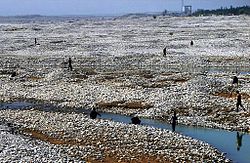White Jade River: Difference between revisions
Added External links section. |
Added ref. |
||
| Line 61: | Line 61: | ||
}} |
}} |
||
{{Chinese|c=玉龙喀什河|p=yùlóng kāshén hé|c2=白玉河|p2=báiyù Hé|w2=Pai<sup>2</sup>-yü<sup>4</sup> Ho<sup>2</sup>|mi2={{IPAc-cmn|b|ai|2|yü|4|-|h|e|2}}|uig=يورۇڭقاش دەرياسى|uly=Yorungqash deryasi|uyy=Yorungⱪax dəryasi|usy=Йоруңқаш дәряси}} |
{{Chinese|c=玉龙喀什河|p=yùlóng kāshén hé|c2=白玉河|p2=báiyù Hé|w2=Pai<sup>2</sup>-yü<sup>4</sup> Ho<sup>2</sup>|mi2={{IPAc-cmn|b|ai|2|yü|4|-|h|e|2}}|uig=يورۇڭقاش دەرياسى|uly=Yorungqash deryasi|uyy=Yorungⱪax dəryasi|usy=Йоруңқаш дәряси}} |
||
The '''White Jade River''', also known by the native names '''Baiyu''' or '''Yurungkash''', is a river in the southern [[Xinjiang]] region of [[China]]. |
The '''White Jade River''', also known by the native names '''Baiyu''' or '''Yurungkash''', is a river in the southern [[Xinjiang]] region of [[China]].<ref>{{cite web |URL=https://www.nytimes.com/2010/09/21/world/asia/21jade.html |title=Jade from China's West Surpasses Gold in Value |publisher=nytimes.com |first=Andrew |last=Jacobs |date=September 20, 2010 | accessdate=November 16, 2018}}</ref> |
||
The head waters of the river rise in the [[Kunlun Mountains]], in the area of Aksai Chin in [[Kashmir]] in the [[Togatax]] area ({{coord|35.6|N|81.4|E}}). The river flows east for some 200 km and then north for another 200 km before passing [[Khotan]] ({{coord|37.11|N|79.97|E}}). North of Khotan, it eventually dries up in the [[Taklamakan desert]], its seasonal bed joined by that of the Black Jade River ([[Karakash River]]) near [[Koxlax]] (some 200 km north of Khotan, {{coord|38.08|N|80.56|E}}), from where it continues north as the [[Khotan River]] passing [[Piqanlik]] ({{coord|40.05|N|80.89|E}}), and seasonally crossing the desert, joining the [[Tarim River]]. The river drains an area of {{convert|14575|km2|mi2|abbr=on}} and has a discharge of {{convert|72.3|m3/s|cuft/s}}. |
The head waters of the river rise in the [[Kunlun Mountains]], in the area of Aksai Chin in [[Kashmir]] in the [[Togatax]] area ({{coord|35.6|N|81.4|E}}). The river flows east for some 200 km and then north for another 200 km before passing [[Khotan]] ({{coord|37.11|N|79.97|E}}). North of Khotan, it eventually dries up in the [[Taklamakan desert]], its seasonal bed joined by that of the Black Jade River ([[Karakash River]]) near [[Koxlax]] (some 200 km north of Khotan, {{coord|38.08|N|80.56|E}}), from where it continues north as the [[Khotan River]] passing [[Piqanlik]] ({{coord|40.05|N|80.89|E}}), and seasonally crossing the desert, joining the [[Tarim River]]. The river drains an area of {{convert|14575|km2|mi2|abbr=on}} and has a discharge of {{convert|72.3|m3/s|cuft/s}}. |
||
Revision as of 00:26, 17 November 2018
| Yurungkash River White Jade River, Baiyu River | |
|---|---|
 Collecting jade in the White Jade River near Khotan in 2011 | |
| Native name | 玉龙喀什河 Error {{native name checker}}: parameter value is malformed (help) |
| Physical characteristics | |
| Source | Kunlun Mountains |
| • coordinates | 35°36′N 81°24′E / 35.6°N 81.4°E |
| Mouth | Hotan River |
• coordinates | 38°05′N 80°34′E / 38.08°N 80.56°E |
| Basin size | 14,575 km2 (5,627 sq mi) |
| Discharge | |
| • average | 72.3 cubic metres per second (2,550 cu ft/s) |
| Basin features | |
| River system | Tarim River |
| White Jade River | |||||||||||
|---|---|---|---|---|---|---|---|---|---|---|---|
| Chinese name | |||||||||||
| Chinese | 玉龙喀什河 | ||||||||||
| |||||||||||
| Alternative Chinese name | |||||||||||
| Chinese | 白玉河 | ||||||||||
| |||||||||||
| Uyghur name | |||||||||||
| Uyghur | يورۇڭقاش دەرياسى | ||||||||||
| |||||||||||
The White Jade River, also known by the native names Baiyu or Yurungkash, is a river in the southern Xinjiang region of China.[1]
The head waters of the river rise in the Kunlun Mountains, in the area of Aksai Chin in Kashmir in the Togatax area (35°36′N 81°24′E / 35.6°N 81.4°E). The river flows east for some 200 km and then north for another 200 km before passing Khotan (37°07′N 79°58′E / 37.11°N 79.97°E). North of Khotan, it eventually dries up in the Taklamakan desert, its seasonal bed joined by that of the Black Jade River (Karakash River) near Koxlax (some 200 km north of Khotan, 38°05′N 80°34′E / 38.08°N 80.56°E), from where it continues north as the Khotan River passing Piqanlik (40°03′N 80°53′E / 40.05°N 80.89°E), and seasonally crossing the desert, joining the Tarim River. The river drains an area of 14,575 km2 (5,627 sq mi) and has a discharge of 72.3 cubic metres per second (2,550 cu ft/s).
The river gets its name from the white jade that is often found in its alluvial deposits. The jade can also however be found in semi-shallow areas of the river.[citation needed].
References
- ^ Jacobs, Andrew (September 20, 2010). "Jade from China's West Surpasses Gold in Value". nytimes.com. Retrieved November 16, 2018.
External links
